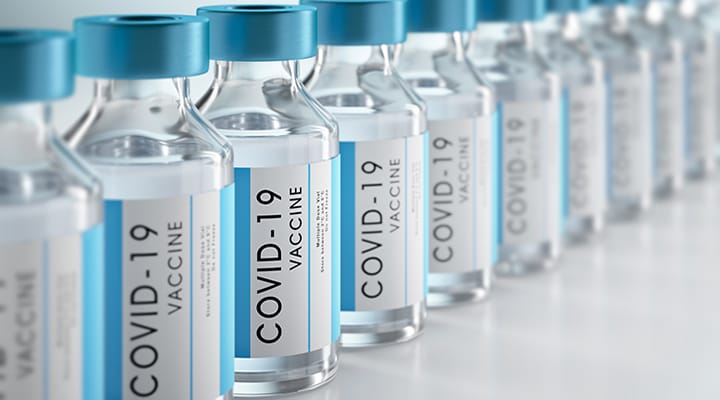The following is an excerpt from The Vaccine Reaction.
Techniker Krankenkasse, Germany’s largest health insurance company, reported that 437,593 of 11 million (1 in 25) insured individuals in 2021 had to undergo medical treatment as a result of adverse reactions from Covid-19 shots.
The German Ministry of Health officially acknowledged that 1 in every 5,000 Covid Shots given will cause serious adverse reactions that lead to hospitalization, permanent disability or death. The Ministry of Health said a person who gets four shots has a one in 1,250 chance of developing a severe adverse reaction.3
Following this announcement by the German Ministry of Health, the German Federation of Hospitals called for the vaccine mandate for healthcare personnel to be revoked. Henriette Neumeyer, vice chairwoman of the board for the German Federation of Hospitals said: “According to the current findings, it is not sensible and not transferable to continue.”
Techniker Krankenkasse reported that in 2019, out of 11 million insured people, 13,777 medical treatments were required as a result of vaccine side effects.
- In 2020, 15,044 medical treatments were carried out as a result of vaccine reactions.
- In 2021, the figure significantly grew to 437,593 medical treatments following vaccine reactions, an increase of more than 3,000 percent.
Based on the Techniker Krankenkasse data, as many as 1 in 500 Covid shots causes a serious reaction.
In February 2022, Andreas Schöfbeck, a board member of BKK ProVita, one of Germany’s oldest health insurance companies, revealed that he noticed that the number of doctor visits as a result of Covid shot reactions among the millions of insured customers was no less than ten times higher than the official figures.
He began investigating the data, which revealed that from the start of 2021 through the middle of the third quarter of 2021, 216,695 BKK ProVita policyholders had been treated for adverse reactions to Covid shots.
Schöfbeck was then fired from his position at BKK ProVita for releasing the data.
Continue reading article here.




Nice to meet you.
UK office for nat. Stats have released
Death figs. For All the jabbed at 1/246
Within the 1st 6 mths. ! 90% all covid deaths came from jabbed population. All cause death rate % doubled for every jab. Where is MSM ?
Well done Sharyl
Idiotic. Cite the source with a link. And read this, dear: https://www.factcheck.org/2022/08/scicheck-misrepresentation-of-germanys-data-on-unverified-covid-19-vaccine-side-effects/
This article is utter bull. https://www.factcheck.org/2022/08/scicheck-misrepresentation-of-germanys-data-on-unverified-covid-19-vaccine-side-effects/ We’ve written several stories about false and misleading claims that distort the Vaccine Adverse Event Reporting System. VAERS, run by the Centers for Disease Control and Prevention and the Food and Drug Administration, serves as an early warning system to detect potential safety problems with vaccines. Anyone can submit a report, and in many cases, health care providers are required to file a report of symptoms that occurred following vaccination, as we’ve explained.
The reports don’t mean that the symptom was necessarily caused by the vaccine, but the reports allow government scientists to detect, and then investigate, potential safety issues. After more than 600 million vaccine doses in the U.S., serious adverse events linked to the vaccines have been rare.
Germany has a similar vaccine safety reporting system that is now being misrepresented in the U.S. by two popular purveyors of misleading information on the COVID-19 vaccines.
Former New York Times reporter Alex Berenson, who has wrongly used VAERS data in the past, said in a July 20 Substack post: “This morning, the German Federal Ministry of Health posted a stunning tweet, admitting that 1 out of every 5,000 Covid jabs cause ‘serious side effects.’” He claimed the statistic “implies that almost 300,000 Americans and Europeans have suffered severe side effects after receiving mRNA shots from Pfizer/BioNTech and Moderna.”
He also posted on Instagram: “The German government admits hundreds of thousands of people have had severe side effects following mRNA shots.”
Fox News’ Tucker Carlson similarly included the claim on his show on July 21 and 22. “Germany’s Ministry of Health found that 1 in 5,000 Germans have suffered ‘serious side effects after a COVID-19 vaccine,’” Carlson asserted on July 21. “That would mean that in the U.S., if that number holds constant across countries — and why wouldn’t it? — it would mean more than 100,000 Americans may have been seriously injured by the COVID vaccine.”
But the German Federal Ministry of Health didn’t find that the vaccines “cause” that rate of “serious side effects.” The figures come from the country’s Paul-Ehrlich-Institut, which is the Federal Institute for Vaccines and Biomedicines and is responsible for overseeing the safety of medicines, much like the FDA. The institute publishes periodic reports on side effects “regardless of the causal link to the vaccination,” as it says in an FAQ on its website. The individual reports on suspected side effects can come from public health officials, doctors or “vaccinated persons or their relatives,” the FAQ says.
The ministry’s initial July 20 tweet, highlighted by Berenson, was incorrect, though it clearly referred to the work of the Paul-Ehrlich-Institut. The tweet, which was later deleted and corrected, said, per Google Translate: “One in 5000 people is affected by a serious side effect after a COVID19 vaccination. If you suspect #side effects, get medical help and report your symptoms to @PEI_Germany,” referring to the institute.
In another tweet posted the same day, the ministry said: “Correction: According to @PEI_Germany, the reporting rate for serious reactions is 0.2 reports per 1,000 vaccine doses.”
But the ministry’s correction still didn’t make clear what this reporting rate meant. In a Twitter thread the next day, the ministry offered more explanation, saying that the “reporting rate refers to all suspicious activity reports, ie a causal connection with the vaccination has not yet been confirmed.”
In other words, the ministry was wrong to initially characterize the reporting rate in that way, implying the reported side effects were all caused by the vaccines when many of them were likely coincidental.
The Paul-Ehrlich-Institut told us that “there are a couple of persisting misunderstandings that continue to lead to misinterpretations” of these safety reports — just as we’ve seen with VAERS.
“[P]lease pay attention to the fact that the report rate refers to all suspected reports, i.e. a causal connection with the vaccination has not yet been confirmed with the report of suspicion. The reporting rate indicates how many suspected cases of adverse events have been reported and will be evaluated by the Paul-Ehrlich-Institut thereafter,” the institute told us in a statement via email.
It also noted that “one reported case of a suspected adverse event may involve several reactions (e.g fever, headache, muscle pain), and the reporting rate is calculated per vaccine dose, not per vaccinated person.”
We reached out to the Federal Ministry of Health as well, but we haven’t received a response.
The float of the city of Mainz, Germany, with Johannes Gutenberg figure and COVID-19 vaccine doses created by Dieter Wenger for the 36th Rhineland-Palatinate Day. May 22, 2022. Photo by Hannes P. Albert/picture alliance via Getty Images.
The Paul-Ehrlich-Institut’s May 4 report said, as the ministry tweeted in its correction: “The reporting rate for serious adverse events was 0.2 reports per 1,000 doses of vaccine.” The time period is Dec. 27, 2020, when vaccinations began in the country, through March 31, 2022. There are five COVID-19 vaccines in use in Germany (see Section 2 of the report), including vaccines from Pfizer/BioNTech, Moderna, Johnson & Johnson, AstraZeneca and Novavax, most of which are two-dose primary vaccinations with booster doses also available. So many people received at least two doses.
But, again, as the report explains in the methodology section, the Paul-Ehrlich-Institut encourages all reports of possible side effects even if the link to vaccination is questionable. Doctors are “legally obligated” to report post-vaccination complications to public health departments if they “are not obviously the result of other causes,” the report said.
“The reporting of suspected cases of adverse events and vaccine-related complications is a central pillar of assessments of vaccine safety because it enables the rapid detection of new safety signals,” the May 4 report said. “It should still be noted here that the reported adverse events are chronologically, but not necessarily causally, linked to vaccination. The reporting of such reactions with a questionable link to vaccination is expressly welcomed. However, this also means that not all reported reactions are actually adverse events. The Paul-Ehrlich-Institut summarises all submitted reports in its safety reports, regardless of the causal link to the vaccination.”
As for what constitutes a “serious” adverse event, the definition is broader for the COVID-19 vaccines than other vaccines. In addition to standard “serious” events, such as fatal and life-threatening events and those requiring hospitalization, reports on “adverse events of particular interest” are classified as “serious” for these vaccines. The institute pointed us to a European Union document listing those events of particular interest, which include dermatological, respiratory, gastrointestinal, liver, eye disorder and pregnancy-related issues, among others (see the AESI, or “adverse events of special interest,” list on page 13). For this reason, the May 4 report says, “a direct comparison with the reports on other vaccines is not possible.”
The institute’s report also gives information on “known adverse events,” such as myocarditis and pericarditis, inflammation of the heart muscle or the outer lining of the heart. As has been found in the U.S., the conditions have been “a very rare side effect” of the Pfizer/BioNTech and Moderna vaccines, mainly affecting young men and adolescents. The “suspected,” but not confirmed, cases showed a reporting rate of under 2 suspected cases per 100,000 doses of those vaccines in Germany.
The institute said the “very rare” cases of anaphylaxis, a severe allergic reaction, have been reported at a frequency of 0.4 or less per 100,000 doses, depending on the vaccine.
The report also said that while fatalities were cited at various times post-vaccination in 2,810 suspected case reports, the institute found that 116 cases had a “probable or possible causal relationship” to COVID-19 vaccination. The reason for that assessment, the institute told us, is the same as explained in the Feb. 7 report on suspected adverse events. These were cases “in which patients died from known vaccination risks such as thrombosis with thrombocytopenia syndrome (TTS), bleeding due to immune thrombocytopenia, or myocarditis occurring within a logical time frame after vaccination,” that report said. TTS is a serious blood clotting disorder coupled with low platelets that is a rare risk associated with the Johnson & Johnson and AstraZeneca vaccines, the latter of which is available in Europe.
During this time period, through March 31, 172 million vaccine doses were administered in Germany.
The May report went on to say that when comparing the total reports of suspected adverse events ending in death up to six weeks after vaccination with the number of statistically expected deaths during the same time period, that comparison “did not indicate a safety signal for any of the five COVID-19 vaccines used so far in Germany.”
In the U.S., there has been a large number of VAERS reports following COVID-19 vaccination, compared with other vaccines, due to expanded reporting requirements and the hundreds of millions of doses given amid intense scrutiny and awareness of the vaccines, as we’ve explained.
Editor’s note: SciCheck’s COVID-19/Vaccination Project is made possible by a grant from the Robert Wood Johnson Foundation. The foundation has no control over our editorial decisions, and the views expressed in our articles do not necessarily reflect the views of the foundation. The goal of the project is to increase exposure to accurate information about COVID-19 and vaccines, while decreasing the impact of misinformation.
[…] (REPORT) Germany: 1 in 25 insured individuals treated for Covid shot adverse reactions | Sharyl Attk… […]